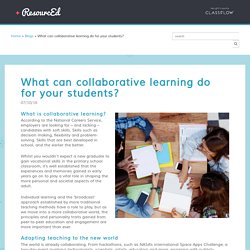

The key to making the shift to active learning (and why technology is not enough) Some public schools (by design) foster passive learners, discourage productivity, and fail to teach self-discipline.

The culture of “school” works against what research shows to be in the best interest of next generation learners. Even if the teacher is talented, the environment itself co-conspires against deep learning (for both the teacher and her learners) and application of what is learned in an authentic context. What is a MOOC? What are the 21st-century skills every student needs?
The gap between the skills people learn and the skills people need is becoming more obvious, as traditional learning falls short of equipping students with the knowledge they need to thrive, according to the World Economic Forum report New Vision for Education: Fostering Social and Emotional Learning Through Technology.

Today's job candidates must be able to collaborate, communicate and solve problems – skills developed mainly through social and emotional learning (SEL). Combined with traditional skills, this social and emotional proficiency will equip students to succeed in the evolving digital economy. Recommendations for the Integration of 21st Century Competences in School. What can collaborative learning do for your students? - ResourcEd. What is collaborative learning?

According to the National Careers Service, employers are looking for – and lacking – candidates with soft skills. Skills such as decision making, flexibility and problem-solving.